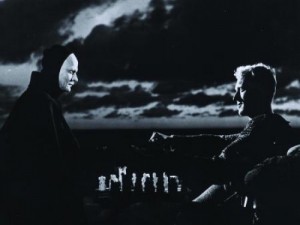by Film Editor Celena Cipriaso
Film in America today is often defined by mega-million-dollar summer blockbusters, idolized movie stars that graze the covers of tabloids, and the industry’s best being lavishly celebrated at the Academy Awards. Because it’s such a monolithic industry, mainstream media often overlooks the fact that movies are more than just the latest Brad Pitt moneymaker or James Cameron CGI extravaganza. With multiplexes available in almost every city and town, film is one of America’s most accessible art forms.
 The first fully successful moving picture camera was engineered in the late 1800s; by the turn of the 20th Century, the American film industry was already beginning to explode. Until 1913, the majority of film production had been based in New York City. The Thomas Edison monopoly of film patents forced many aspiring filmmakers to set up shop in Southern California. To this day, Hollywood remains the home to the major film studios, often referred to as the “Big Six” — Warner Brothers, Paramount, Fox Entertainment, Disney, Sony, and NBC Universal.
The first fully successful moving picture camera was engineered in the late 1800s; by the turn of the 20th Century, the American film industry was already beginning to explode. Until 1913, the majority of film production had been based in New York City. The Thomas Edison monopoly of film patents forced many aspiring filmmakers to set up shop in Southern California. To this day, Hollywood remains the home to the major film studios, often referred to as the “Big Six” — Warner Brothers, Paramount, Fox Entertainment, Disney, Sony, and NBC Universal.
Over the years, America has been an amazing landscape for the evolution of film. Early silent film classics included D. W. Griffith’s technically innovative but controversial Birth of a Nation. In the 1920s, there was The Jazz Singer, the first “talkie” film. In the 1940s, Orson Welles created his masterpiece, Citizen Kane, often called the best film of all time, which introduced revolutionary cinematography and storytelling techniques.
In the 1920s, there was The Jazz Singer, the first “talkie” film. In the 1940s, Orson Welles created his masterpiece, Citizen Kane, often called the best film of all time, which introduced revolutionary cinematography and storytelling techniques.
By the late 1960s, studios were suffering from big budget studio losses such as Cleopatra and Hello, Dolly! In an attempt to capture a younger audience drawn to European art house fare, studios hired a slew of younger producers and filmmakers. These films had more sex, violence, and placed an emphasis on the artistic potential of film. Soon after, the industry saw the influx of work from influential auteur driven directors such as Martin Scorsese, Francis Ford Coppola, Steven Spielberg, and George Lucas.
 After Jaws and Star Wars gave rise to the Hollywood blockbuster, by the 1990s, many films had production budgets at $100 million dollars or more. At the same time, standout independent films such as Pulp Fiction pushed Hollywood studios to create independent film divisions.
After Jaws and Star Wars gave rise to the Hollywood blockbuster, by the 1990s, many films had production budgets at $100 million dollars or more. At the same time, standout independent films such as Pulp Fiction pushed Hollywood studios to create independent film divisions.
The early part of this century was affected by a post 9/11 consciousness, and the effects of the Iraq War. For the first time, documentary film became a viable commercial genre with March of the Penguins, Fahrenheit 9/11, and An Inconvenient Truth. By 2009, the success and technical innovation of Avatar launched a trend to elevate the 3D experience for moviegoers.
 What makes film exciting is that it is an ever-evolving industry with innovations occurring with both mainstream studios and independent production companies. If you’re a diehard film lover, don’t limit yourself to what your local movie theater offers. There are many, many opportunities for film appreciation in America that have nothing to do with Hollywood.
What makes film exciting is that it is an ever-evolving industry with innovations occurring with both mainstream studios and independent production companies. If you’re a diehard film lover, don’t limit yourself to what your local movie theater offers. There are many, many opportunities for film appreciation in America that have nothing to do with Hollywood.
Resources
Books – A great place for budding cinephiles to start is Film History: An Introduction, by Kristin Thompson and David Bordwell, which gives the comprehensive background of both Hollywood and international cinema. There’s also Movie-Made America: A Cultural History of American Movies, by the pioneering film historian Robert Sklar. Roger Ebert, the dean of American film critics, is still wonderfully prolific; high points of his oeuvre include Awake in the Dark: The Best of Roger Ebert, as well as his ongoing Great Movies series. Lovers of old movie houses should check out Cinema Treasures: A New Look at Classic Movie Theaters, by Ross Melnick and Andreas Fuchs. For an innovative look at the history of African-Americans in cinema, there’s Toms, Coons, Mulattoes, Mammies and Bucks: An Interpretive History of Blacks in American Films by Donald Bogle.
DVDs – Essential Art House – 50 Years of Janus Films is pricey, but as an introduction to “art house” films, this stout package – which collects 50 of the finest international films of the last seventy years along with a 200-page hardcover guide – is tough to beat.
Websites – AMC’s History of Film section does a great breakdown of film’s evolution decade by decade. For the latest independent film news, there’s Indiewire. For other film industry news, check out Ain’t It Cool News.

 Film
Film